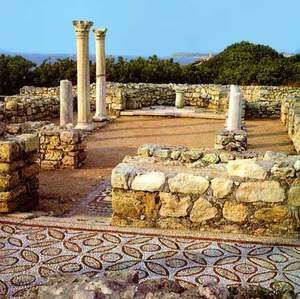An exhibition called “The Capitals of the Turkish-Tatar Khanats”, took place in Kazan (Tatarstan, Russia), underlines the history of establishment and development of the old capital of the Crimean Khanate – Bakhchisarai.
As it informs QHA with a link to Tatarlar.ru, the exhibition “The Capitals of the Turkish-Tatar Khanats” was opened in the Museum of the History of Tatar people statehood and the Republic of Tatarstan on 9 December. The exhibition is being hold within the programme of the cultural heritage preservation “Miras-Preservation” of the Sh. Mardjani's Institute of History of the Academy of Sciences of Tatarstan.
The Exhibition is aimed to lighten the history of establishment and development of the capitals of the Turkish-Tatar Khanats – Bakhchisarai, Bulgar, Saray-Bati, Kurmasha, Kazan, Kasimov and Hachi-Tarhan (Astrahan) in the period from the X to XVIII centuries.
In the exhibition there were used reach archaeological collections, found during the archaeological excavations, held by the Mardjani's Institute of History of the Academy of Sciences of Tatarstan and within the funds creation of the Kazan Kremlin State Historical and Architectural Museum. Besides that, there were also used the collections from the funds of the Bilyarsk State Historical and Architectural and Natural Museum-Reserve and the Nizhiy Novgorod's State Historical and Architectural Museum.
The most part of the exhibition made up article of cartography and graphic arts, such as original maps and engraving dated by the XVI-XVII centuries from the collection of the Avrora 1991 Gallary, items of painting from the funds of the Millenary of Kazan Museum, and also the literary works from the funds of the Science library of the N.I. Lobachevskiy's Nizhniy Novgorod State University .
Moreover, there were used also a unique etching collections of the early XIX century, done from the pictures of E. M. Kornyeyev, the member of the Russian Academy of Arts, and included in a two-volume album “The Nations of Russia”, published in Paris in 1812.
It worth to stress that the exhibition called “The Capitals of the Turkish-Tatar Khanats” is the first project focused to lighten the history of the capitals of the Turkish and Tatar states of X-XVIII centuries, and also to give information about the traditions of statehood, mutual and spiritual culture of the Turkish and Tatar Nations.
Reference. The Crimean Khanate or the Khanate of Crimea (Crimean Tatar: Qırım Hanlığı, قريم خانلغى;) was a Crimean Tatar state from 1441 to 1783. Its native name was Crimean Yurt (Crimean Tatar: Qırım Yurtu, قريم يورتى). The Khanate was by far the longest-lived of the Turkic khanates that succeeded the empire of the Golden Horde. The Khanate included the Crimean peninsula (except the south and southwest coast and ports, controlled by the Republic of Genoa) and the steppes of modern southern Ukraine and Russia, also known as Desht-i-Qırchaq. In 1478 The Crimean Khanate entered into alliance with the Ottoman Empire and was an ally till 1774 when the Treaty of Kyuchyuk-Kainarji was signed, which made the Crimean Khanate independent from the Ottoman Empire, and aligned it with the Russian Empire. On 8 April 1783, in violation of the treaty, Catherine II interfered into the civil war, de facto annexing the whole peninsula into the Russian Empire as Taurida Governorate.
By QHA
Related Links:
"Salachiq" exhibits to be handed over to Bagchasaray reserve
Austria Returns to Ukraine Cultural Values of the Crimean Tatars and Karaims



